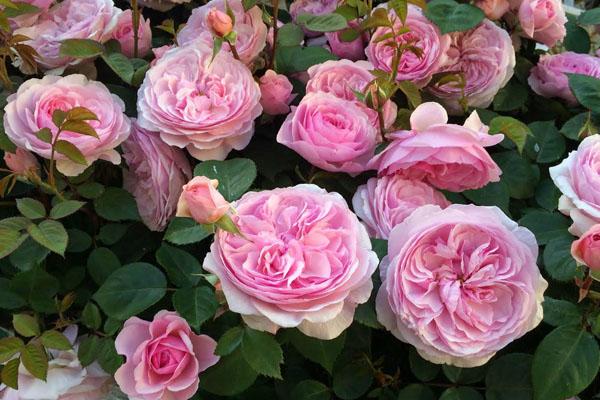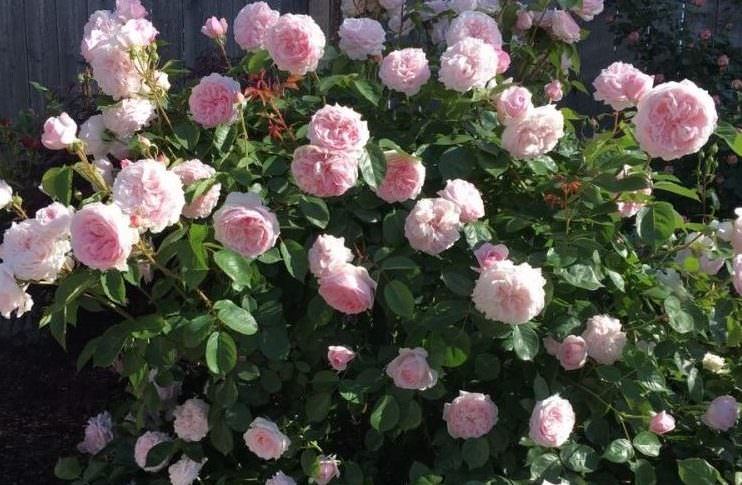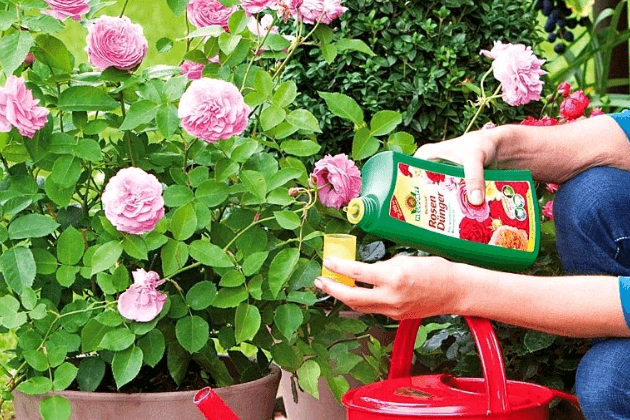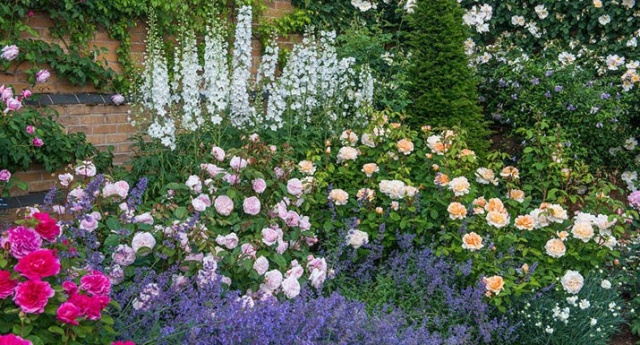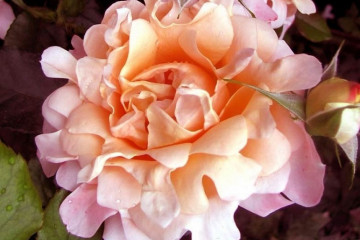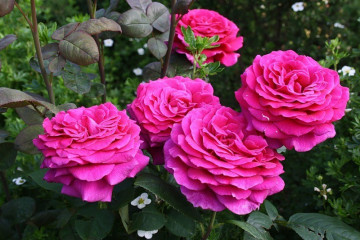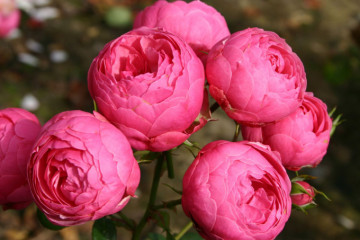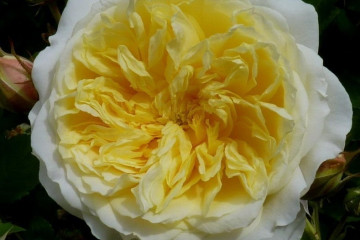Rose Olivia Rose - description of varietal shrub
Content:
Olivia Rose Austin's romantic soft pink roses, created by David Austin in 2005, are capturing the hearts of flower lovers around the world. In modern varieties of English roses, the ancient refinement of the flower and the variety of shades are successfully combined with endurance and long flowering. Most Ostins are characterized by an intense floral-fruity aroma and excellent winter hardiness - the Olivia rose is no exception.
Description
The Olivia Rose variety was registered in 2005 and immediately became one of the most promising new products on the market.
Due to its compact size (width 0.7 m, height 0.9-1 m) and round, harmonious shape of the bush, it is suitable for creating arrays and mixborders.
It blooms in small clusters, 3-5 buds each. Densely double (more than 40 petals) flowers open in the form of a neat rosette, from warm pink in the center to pale at the edge. In full dissolution, golden yellow stamens are visible.
The medium-sized flower (6-8 cm) has a strong tea rose aroma with gentle fruity notes. One of the Austin varieties with peduncles that do not droop, but are arranged vertically.
The rose is very hardy, perfectly withstands precipitation, the buds can only be damaged by prolonged rains. In full sun, the life of a flower is about 5 days. Burns out somewhat. In the southern regions, it is advisable to plant the plant in an openwork shade from trees or in the eastern (western) exposure, since a pale pink rose in the sun fades to pale white.
A mature bush consistently produces 2-3 waves of flowering, and in a temperate climate, the Olivia Rose grows well even in shaded areas.
Excellent resistance to the most common fungal diseases: black spot and powdery mildew.
Care features
Olivia Rose Austin is a rose that, subject to the rules of agricultural technology, blooms very abundantly and for a long time, up to frost. Therefore, knowledge of the features of care is a must for all gardeners.
Landing
You can plant the plant in the second half of spring or in the first half of autumn.
The rose should be planted in a ventilated, lighted area. When choosing a place, it should be borne in mind that the variety does not tolerate waterlogging of the root system. It is recommended to avoid lowlands and places with a high groundwater table.
The ideal soil for growing the variety should be:
- nutritious, high in humus;
- permeable to moisture and air;
- neutral or slightly acidic (pH 5.5-6.5).
You can improve the quality of heavy soil by adding the following ingredients:
- sand;
- peat;
- vegetable compost;
- ash;
- rotted manure and bird droppings.
Poor sandy soil can be ennobled with nutrient substrates, they retain moisture and contribute to the enrichment of nutrients:
- vegetable and food compost;
- peat;
- sod land;
- clay;
- silt
The acidity level of the soil can be checked using special tests or using litmus paper. To provide the rose with comfortable conditions, the following should be added to the alkaline soil:
- peat;
- coniferous litter;
- superphosphate.
To lower the level of acidity (alkalinization), add to the soil:
- lime (carefully and in small doses, so as not to slow down the growth of the plant);
- dolomite flour;
- bone meal;
- ash.
Seedlings purchased with an open root system (OCS) should be kept for 1 hour to 1 day in a bucket of water before planting, you can add a rooting agent or a growth biostimulator for plants.
Before planting, the seedling should be carefully inspected for dry, damaged or broken branches, they must be cut with a sharp, disinfected pruner.
The roots also need to be renewed in the cut to a living tissue, it is white.
For early flowering, the shoots are shortened by 10-15 cm from the root collar before spring planting; in the fall, they only slightly refresh the cut.
In unfavorable weather conditions, roses can be placed in a container with wet sand before planting and left in a cool place.
Top dressing
Austin Rose Olivia Rose blooms profusely, which means it needs regular feeding to recover and repeat.
The best result can be obtained with the combined use of organic and mineral fertilizers.
The first feeding of roses is done immediately after the spring sanitary pruning. When choosing fertilizers, it is important to understand what the rose needs at this stage of the growing season.
Nitrogen is responsible for building up green mass. Too much will create a strong, fluffy bush, but will reduce flowering. This is especially evident when fattening shoots appear that do not form peduncles. You can fix the situation by pinching the top of such an escape. High nitrogen content in organic fertilizers:
- cow, horse manure;
- rabbit, bird droppings;
- vegetable and food compost.
Iron deficiency is especially evident in alkaline soils, and provokes chlorosis. The disease can be recognized by the leaves lightening between the veins.
Nitrogen-containing top dressing is applied until mid-summer, young shoots should ripen before the onset of winter. Since July, for a successful wintering, roses are fertilized with potassium-phosphorus complexes. The last dressing is applied in September, here you can use:
- wood ash;
- superphosphate;
- potassium nitrate;
- potassium magnesium.
Pruning
A necessary element of rose care is pruning. The main or sanitary one is performed after the winter shelter is removed from the roses, and before the buds begin to awaken. All dry, broken, with traces of mold or spots of branches are cut out on the bush. The cut is made over the upper living kidney, at an angle of 45 °, so that the water flows from it. It should be cut to live wood, residues with darkening of an infectious burn can lead to rose disease.
Since the cultivar forms a neat, harmonious bush, it rarely needs formative pruning. It is important to ensure that the plant does not thicken with branches growing inward.
After 3-4 years of life, the bushes require rejuvenating pruning, when the oldest and lignified branches are cut to the root collar, stimulating the growth of replacement shoots (basal). Correct pruning will keep the rose bush decorative for a long time.
Preparing for winter
The rose has winter hardiness up to -23 ° С, in temperate and warm climates it can winter without shelter. It is prepared for wintering by hilling it high (25-30 cm) with a mixture of soil and sand, covering it with spruce branches.In cold climates, it is recommended to wrap the bush with a special covering material; for the northern regions, a frame shelter is required.
Flower propagation
You can propagate a rose by rooting cuttings from an adult, more than 3 years old, a bush. The procedure does not differ from that of other varieties.
It is best to choose the shoots on which the roses have already faded. The selection criterion is the strength of the thorns: if the thorns on the stem break off, then the shoot is already mature.
It is advisable to cut the stalk in the morning or late in the evening, closer to the night. The cut must be performed with a sharp, disinfected instrument.
Cutting size: 12-15 cm. Each has 2-3 leaves and the same number of buds.
If the procedure is carried out in the summer, then cuttings can be planted right in the garden by filling the planting hole with nutritious soil (the same soil is prepared as for an adult plant). Cuttings need to be stuck at an angle of 45 °, covered with jars, and watered regularly. Rooting will occur in about a month.
If the procedure is carried out closer to autumn, then you will have to place the cuttings in pots or boxes. The rest of the process is similar. The seedlings will winter indoors, and in the spring they can be planted outdoors.
Diseases and pests
Olivia Rose D. Austin has good immunity against diseases, recovers well after an unsuccessful winter.
In summer, young shoots and buds can attract caterpillars and aphids. If there are few pests, the plant is cleaned by hand and sprayed with soapy water or an infusion of wood ash. With a strong and regular infestation by insects, it is recommended to treat the bushes with a systemic fungicide. You can buy the necessary preparations at any gardening store.
English park rose Olivia Rose is a versatile variety that can be used in the array to create alleys and borders. Perfect for container planting in northern regions. The pastel color of the flowers allows the plant to be used in combined plantings with brighter varieties of roses, ornamental grasses and perennials.
